Multi-Band Up-Converted Lasing Behavior in NaYF4:Yb/Er Nanocrystals
Abstract
1. Introduction
2. Materials and Methods
3. Results
3.1. Morphology and Structural Characterization
3.2. Up-Conversion Luminescence Properties
3.3. NaYF4:Yb,Er NCs Up-Converted Random Lasers
4. Conclusions
Author Contributions
Funding
Conflicts of Interest
References
- Wu, K.; Cui, J.; Kong, X.; Wang, Y. Temperature dependent upconversion luminescence of Yb/Er codoped NaYF4 nanocrystals. J. Appl. Phys. 2011, 110, 053510. [Google Scholar] [CrossRef]
- Yao, Y.; Xu, C.; Zheng, Y.; Yang, C.; Liu, P.; Jia, T.; Qiu, J.; Sun, Z.; Zhang, S. Femtosecond Laser-Induced Upconversion Luminescence in Rare-Earth Ions by Nonresonant Multiphoton Absorption. J. Phys. Chem. A 2016, 120, 5522–5526. [Google Scholar] [CrossRef] [PubMed]
- Wang, Y.; Zhu, Y.; Yang, X.; Shen, J.; Li, X.; Qian, S.; Li, C. Performance optimization in dye-sensitized solar cells with β-NaYF4:Yb3+,Er3+@SiO2@TiO2 mesoporous microspheres as multi-functional photoanodes. Electrochim. Acta 2016, 211, 92–100. [Google Scholar] [CrossRef]
- Giang, L.T.K.; Marciniak, L.; Hreniak, D.; Anh, T.K.; Minh, L.Q. Synthesis, Structural Characterization, and Emission Properties of NaYF4:Er3+/Yb3+ Upconversion Nanoluminophores. J. Electron. Mater. 2016, 45, 4790–4795. [Google Scholar] [CrossRef]
- Deng, R.; Qin, F.; Chen, R.; Huang, W.; Hong, M.; Liu, X. Temporal Full-Colour Tuning through Non-Steady-State Upconversion. Nat. Nanotechnol. 2015, 10, 237–242. [Google Scholar] [CrossRef] [PubMed]
- Xue, Z.; Zeng, S.; Hao, J. Non-invasive through-skull brain vascular imaging and small tumor diagnosis based on NIR-II emissive lanthanide nanoprobes beyond 1500 nm. Biomaterials 2018, 171, 153–163. [Google Scholar] [CrossRef] [PubMed]
- Liu, S.; Tian, B.; Wu, S.; Wang, Y.; Huang, J.; Gao, B.; Jin, L.; Li, K.; Wang, Z. pH-sensitive polymer-gated multifunctional upconversion NaYF4:Yb/Er@mSiO2 nanocomposite for oral drug delivery. Microporous Mesoporous Mater. 2018, 264, 151–158. [Google Scholar] [CrossRef]
- Niazi, S.; Wang, X.; Pasha, I.; Khan, I.M.; Zhao, S.; Shoaib, M.; Wu, S.; Wang, Z. A novel bioassay based on aptamer-functionalized magnetic nanoparticle for the detection of zearalenone using time resolved-fluorescence NaYF4: Ce/Tb nanoparticles as signal probe. Talanta 2018, 186, 97–103. [Google Scholar] [CrossRef] [PubMed]
- Yin, X.; Wang, H.; Tian, Y.; Xing, M.; Fu, Y.; Luo, X. Three primary color emissions from single multilayered nanocrystals. Nanoscale 2018, 10, 9673–9678. [Google Scholar] [CrossRef] [PubMed]
- Li, H.; Lei, W.; Wu, J.; Li, S.; Zhou, G.; Liu, D.; Yang, X.; Wang, S.; Li, Z.; Zhang, J. An upconverting nanotheranostic agent activated by hypoxia combined with NIR irradiation for selective hypoxia imaging and tumour therapy. J. Mater. Chem. B 2018, 6, 2747–2757. [Google Scholar] [CrossRef]
- Heer, S.; Kompe, K.; Gudel, H.U.; Haase, M. Highly efficient multicolour upconversion emission in transparent colloids of lanthanide-doped NaYF4 nanocrystals. Adv. Mater. 2004, 16, 2102–2105. [Google Scholar] [CrossRef]
- Zhang, S.; Xu, S.; Ding, J.; Lu, C.; Jia, T.; Qiu, J.; Sun, Z. Single and Two-Photon Fluorescence Control of Er3+ Ions by Phase-Shaped Femtosecond Laser Pulse. Appl. Phys. Lett. 2014, 104, 014101. [Google Scholar] [CrossRef]
- Zhang, S.; Lu, C.; Jia, T.; Qiu, J.; Sun, Z. Coherent Phase Control of Resonance-Mediated Two-Photon Absorption in RareEarth Ions. Appl. Phys. Lett. 2013, 103, 194104. [Google Scholar] [CrossRef]
- DaCosta, M.V.; Doughan, S.; Han, Y.; Krull, U.J. Lanthanide upconversion nanoparticles and applications in bioassays and bioimaging: A review. Anal. Chim. Acta 2014, 832, 1–33. [Google Scholar] [CrossRef] [PubMed]
- He, G.S.; Tan, L.-S.; Zheng, Q.; Prasad, P.N. Multiphoton Absorbing Materials: Molecular Designs, Characterizations, and Applications. Chem. Rev. 2008, 108, 1245–1330. [Google Scholar] [CrossRef] [PubMed]
- Chen, G.; Qiu, H.; Prasad, P.N.; Chen, X. Upconversion nanoparticles: Design, nanochemistry, and applications in theranostics. Chem. Rev. 2014, 114, 5161–5214. [Google Scholar] [CrossRef] [PubMed]
- Li, Z.; Zhang, Y. An efficient and user-friendly method for the synthesis of hexagonal-phase NaYF(4):Yb, Er/Tm nanocrystals with controllable shape and upconversion fluorescence. Nanotechnology 2008, 19, 345606. [Google Scholar] [CrossRef] [PubMed]
- Zeng, J.H.; Su, J.; Li, Z.H.; Yan, R.X.; Li, Y.D. Synthesis and upconversion luminescence of hexagonal-phase NaYF4:Yb, Er3+ phosphors of controlled size and morphology. Adv. Mater. 2005, 17, 2119–2123. [Google Scholar] [CrossRef]
- Lin, H.-I.; Shen, K.-C.; Liao, Y.-M.; Li, Y.-H.; Perumal, P.; Haider, G.; Cheng, B.H.; Liao, W.-C.; Lin, S.-Y.; Lin, W.-J.; et al. Integration of Nanoscale Light Emitters and Hyperbolic Metamaterials: An Efficient Platform for the Enhancement of Random Laser Action. ACS Photonics 2018, 5, 718–727. [Google Scholar] [CrossRef]
- Sun, T.M.; Wang, C.S.; Liao, C.S.; Lin, S.Y.; Perumal, P.; Chiang, C.W.; Chen, Y.F. Stretchable Random Lasers with Tunable Coherent Loops. ACS Nano 2015, 9, 12436–12441. [Google Scholar] [CrossRef] [PubMed]
- Wiersma, D.S. The physics and applications of random lasers. Nat. Phys. 2008, 4, 359–367. [Google Scholar] [CrossRef]
- Redding, B.; Choma, M.A.; Cao, H. Speckle-free laser imaging using random laser illumination. Nat. Photonics 2012, 6, 355–359. [Google Scholar] [CrossRef] [PubMed]
- Polson, R.C.; Varden, Z.V. Random lasing in human tissues. Appl. Phys. Lett. 2004, 85, 1289–1291. [Google Scholar] [CrossRef]
- Mai, H.-X.; Zhang, Y.-W.; Si, R.; Yan, Z.-G.; Sun, I.-D.; You, L.-P.; Yan, C.-H. High-Quality Sodium Rare-Earth Fluoride Nanocrystals: Controlled Synthesis and Optical Properties. J. Am. Chem. Soc. 2006, 128, 6426–6436. [Google Scholar] [CrossRef] [PubMed]
- Song, Q.; Liu, L.; Xiao, S.; Zhou, X.; Wang, W.; Xu, L. Unidirectional high intensity narrow-linewidth lasing from a planar random microcavity laser. Phys. Rev. Lett. 2006, 96, 033902. [Google Scholar] [CrossRef] [PubMed]
- Yamauchi, T.; Arakawa, Y.; Nishioka, M. Enhanced and inhibited spontaneous emission in GaAs/AlGaAs vertical microcavity lasers with two kinds of quantum wells. Appl. Phys. Lett. 1991, 58, 2339–2341. [Google Scholar] [CrossRef]
- Suzuki, M.; Yokoyama, H.; Brorson, S.D.; Ippen, E.P. Observation of spontaneous emission lifetime change of dye-containing Langmuir–Blodgett films in optical microcavities. Appl. Phys. Lett. 1991, 58, 998–1000. [Google Scholar] [CrossRef]
- Li, D.; Lai, W.-Y.; Shao, Q.; Huang, W. Facile synthesis of ultrasmall hexagonal NaYF4Yb3+,Er3+ upconversion nanocrystals through temperature oscillation. Inorg. Chem. Front. 2017, 4, 1211. [Google Scholar] [CrossRef]
- Chen, X.; Zhu, Y.; Zhou, D.; Xu, W.; Zhu, J.; Pan, G.; Yin, Z.; Wang, H.; Cuie, S.; Song, H. Size-dependent downconversion near-infrared emission of NaYF4Yb3+,Er3+ nanoparticles. J. Mater. Chem. C 2017, 5, 2451–2458. [Google Scholar] [CrossRef]
- Yi, G.S.; Chow, G.M. Synthesis of Hexagonal-Phase NaYF4:Yb,Er and NaYF4:Yb,Tm Nanocrystals with Efficient Up-Conversion Fluorescence. Adv. Funct. Mater. 2006, 16, 2324–2329. [Google Scholar] [CrossRef]
- Sui, Y.; Tao, K.; Tian, Q.; Sun, K. Interaction Between Y3+ and Oleate Ions for the Cubic-to-Hexagonal Phase Transformation of NaYF4 Nanocrystals. J. Phys. Chem. C 2012, 116, 1732–1739. [Google Scholar] [CrossRef]
- Zhou, R.; Li, X. Effect of EDTA on the formation and upconversion of NaYF4:Yb3+/Er3+. Opt. Mater. Express 2016, 6, 1313. [Google Scholar] [CrossRef]
- Li, Z.; Zhang, Y.; Jiang, S. Multicolor Core/Shell-Structured Upconversion Fluorescent Nanoparticles. Adv. Mater. 2008, 20, 4765–4769. [Google Scholar] [CrossRef]
- Wang, T.; Yu, H.; Siu, C.K.; Qiu, J.; Xu, X.; Yu, S.F. White-Light Whispering-Gallery-Mode Lasing from Lanthanide-Doped Upconversion NaYF4 Hexagonal Microrods. ACS Photon. 2017, 4, 1539–1543. [Google Scholar] [CrossRef]
- Vetrone, F.; Boyer, J.-C.; Capobianco, J.A. Significance of Yb3+ concentration on the upconversion mechanisms in codoped Y2O3:Er3+,Yb3+ nanocrystals. J. Appl. Phys. 2004, 96, 661–667. [Google Scholar] [CrossRef]
- Ren, G.; Zeng, S.; Hao, J. Tunable multicolor upconversion emissions and paramagnetic property of monodispersed bifunctional lanthanide-doped NaGdF4 nanorods. J. Phys. Chem. C 2011, 115, 20141–20147. [Google Scholar] [CrossRef]
- Pollnau, M.; Gamelin, D.R.; Lüthi, S.R.; Güdel, H.U. Power dependence of upconversion luminescence in lanthanide and transition-metal-ion systems. Phys. Rev. B. 2000, 61, 3337–3345. [Google Scholar] [CrossRef]
- Yamada, N.; Shionoya, S.; Kushida, T. Phonon-Assisted Energy Transfer between Trivalent Rare Earth Ions. J. Phys. Soc. Jpn. 1972, 32, 1577–1586. [Google Scholar] [CrossRef]
- Chen, R.; Bakti Utama, M.I.; Peng, Z.; Peng, B.; Xiong, Q.; Sun, H. Excitonic properties and near-infrared coherent random lasing in vertically aligned CdSe nanowires. Adv. Mater. 2011, 23, 1404–1408. [Google Scholar] [CrossRef] [PubMed]
- Yang, H.Y.; Yu, S.F.; Shu, P.L.; Yan, B.; Yu, T. Random lasing from ZnO nanowires system. In Proceedings of the 2009 14th OptoElectronics and Communications Conference (OECC 2009), Hong Kong, China, 13–17 July 2009; pp. 1–2. [Google Scholar]
- Stassinopoulos, A.; Das, R.N.; Giannelis, E.P.; Anastasiadis, S.H.; Anglos, D. Random lasing from surface modified films of zinc oxide nanoparticles. Appl. Surface Sci. 2005, 247, 18–24. [Google Scholar] [CrossRef]
- Xu, X.; Zhang, W.; Jin, L.; Qiu, J.; Yu, S.F. Random lasing in Eu(3)(+) doped borate glass-ceramic embedded with Ag nanoparticles under direct three-photon excitation. Nanoscale 2015, 7, 16246–16250. [Google Scholar] [CrossRef] [PubMed]
- Lin, J.-H.; Hsiao, Y.-L.; Ciou, B.-Y.; Lin, S.-H.; Chen, Y.-H.; Wu, J.-J. Manipulation of Random Lasing Action From Dye-Doped Liquid Crystals Infilling Two-Dimensional Confinement Single Core Capillary. IEEE Photonics J. 2015, 7, 1501809. [Google Scholar] [CrossRef]
- Wan, Y.; An, Y.; Deng, L. Plasmonic enhanced low-threshold random lasing from dye-doped nematic liquid crystals with TiN nanoparticles in capillary tubes. Sci. Rep. 2017, 7, 16185. [Google Scholar] [CrossRef] [PubMed]
- Sandberg, R.; Mølhave, K.; Boisen, A.; Svendsen, W. Effect of gold coating on the Q-factor of a resonant cantilever. J. Micromech. Microeng. 2005, 15, 2249–2253. [Google Scholar] [CrossRef]
- Gummaluri, V.S.; Nair, R.V.; Krishnan, S.R.; Vijayan, C. Femtosecond laser-pumped plasmonically enhanced near-infrared random laser based on engineered scatterers. Opt. Lett. 2017, 42, 5002–5005. [Google Scholar] [CrossRef] [PubMed]
- Liu, S.; Sun, W.; Li, J.; Gu, Z.; Wang, K.; Xiao, S.; Song, Q. Random lasing actions in self-assembled perovskite nanoparticles. Opt. Eng. 2016, 55, 057102. [Google Scholar] [CrossRef]
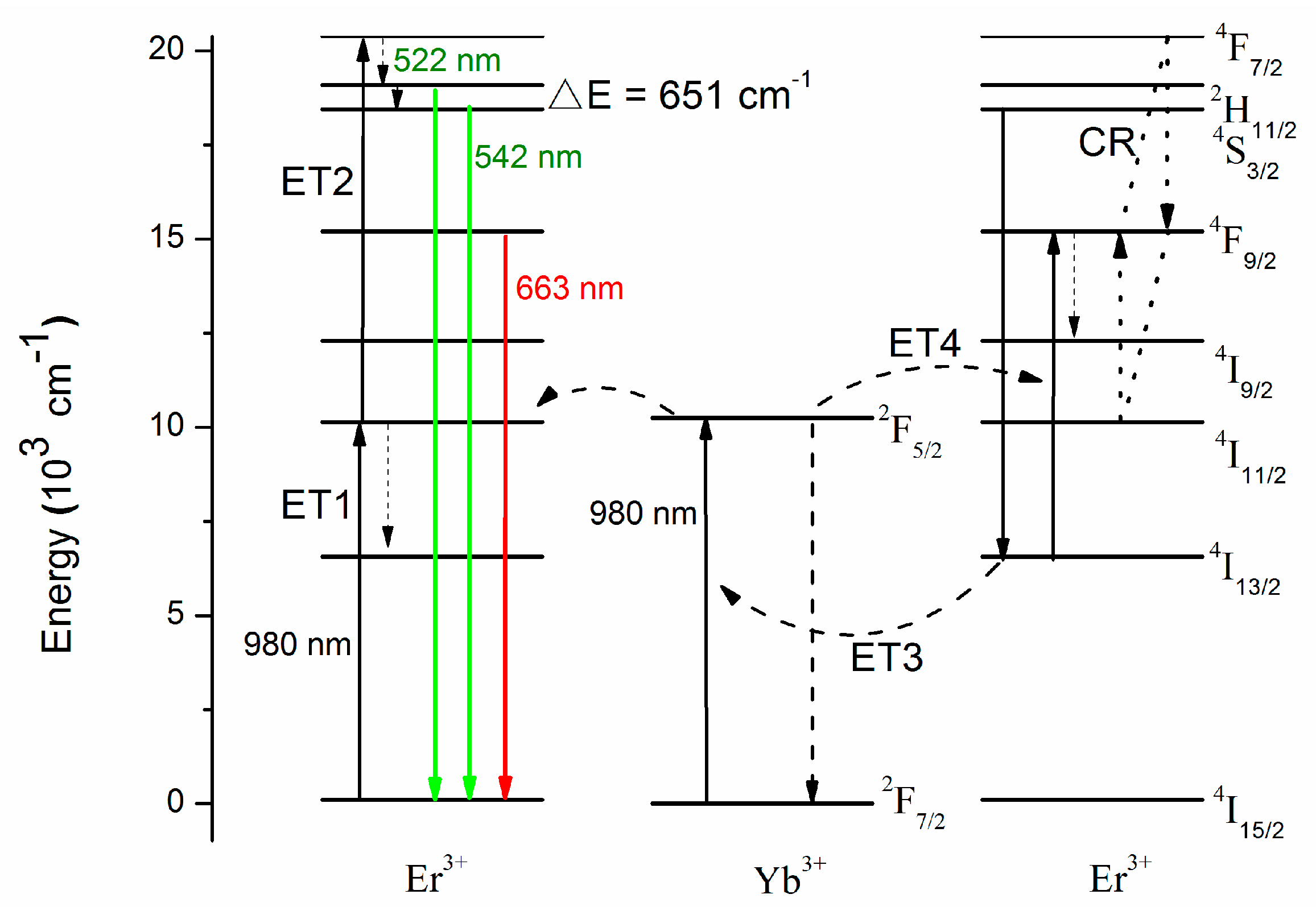
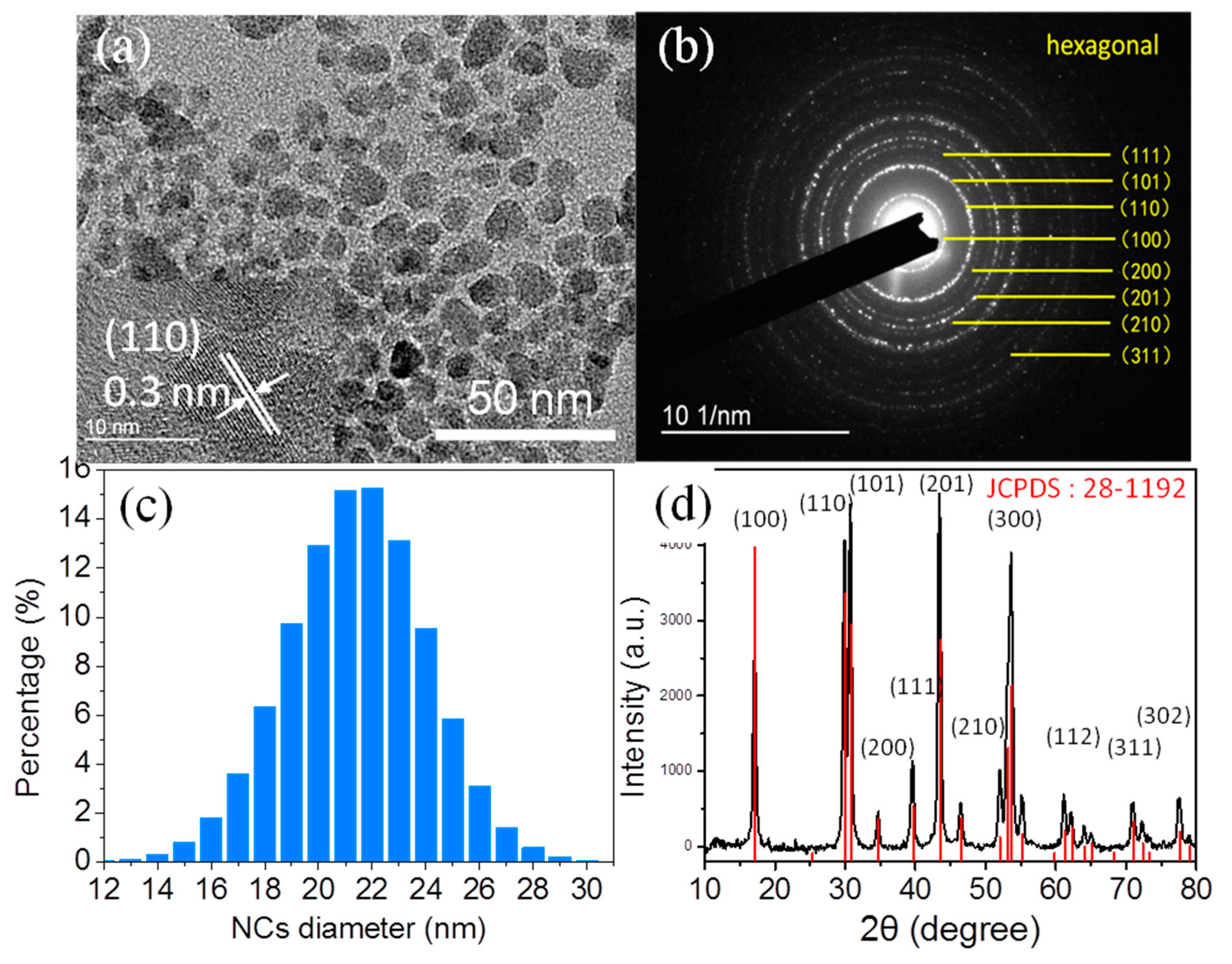
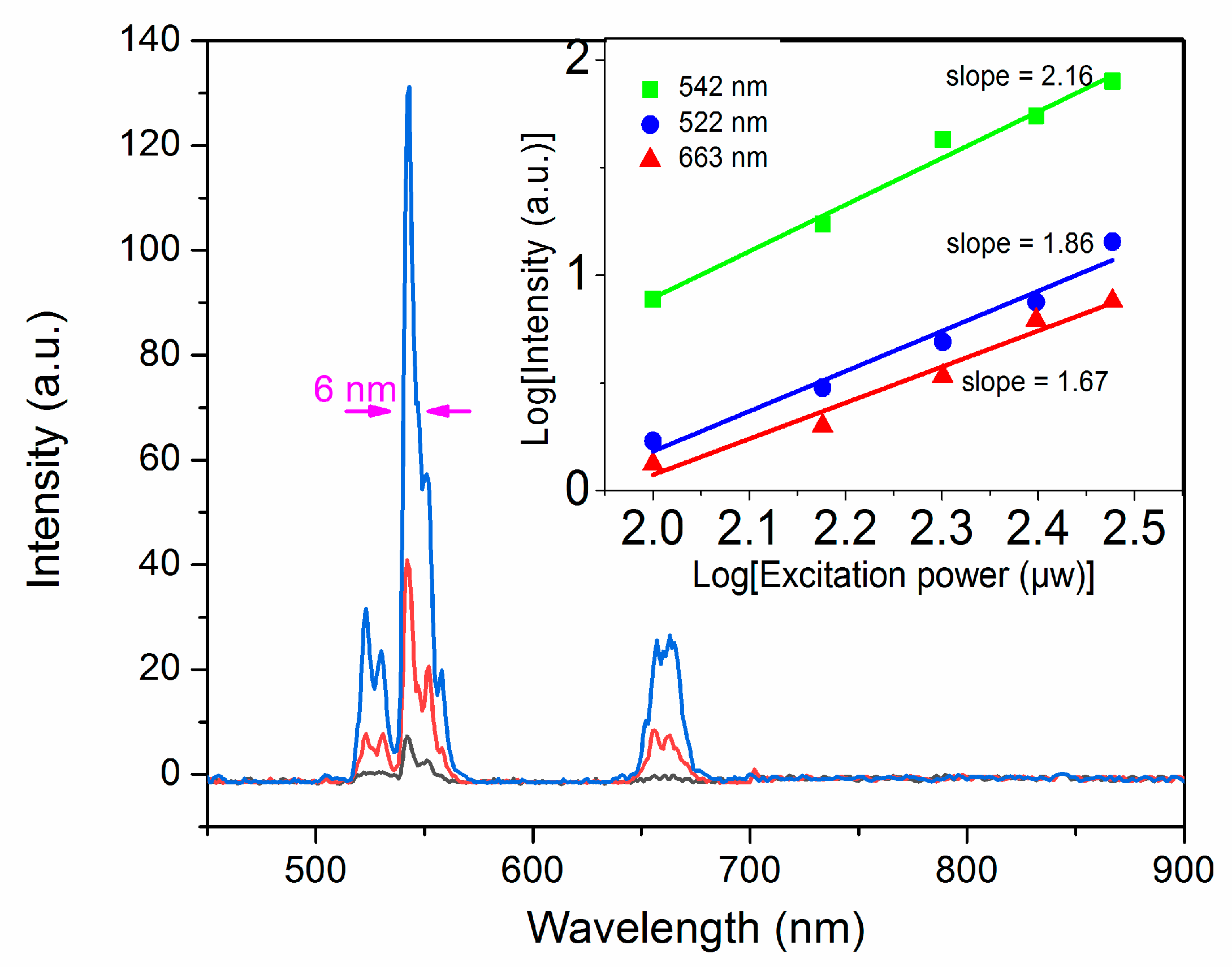
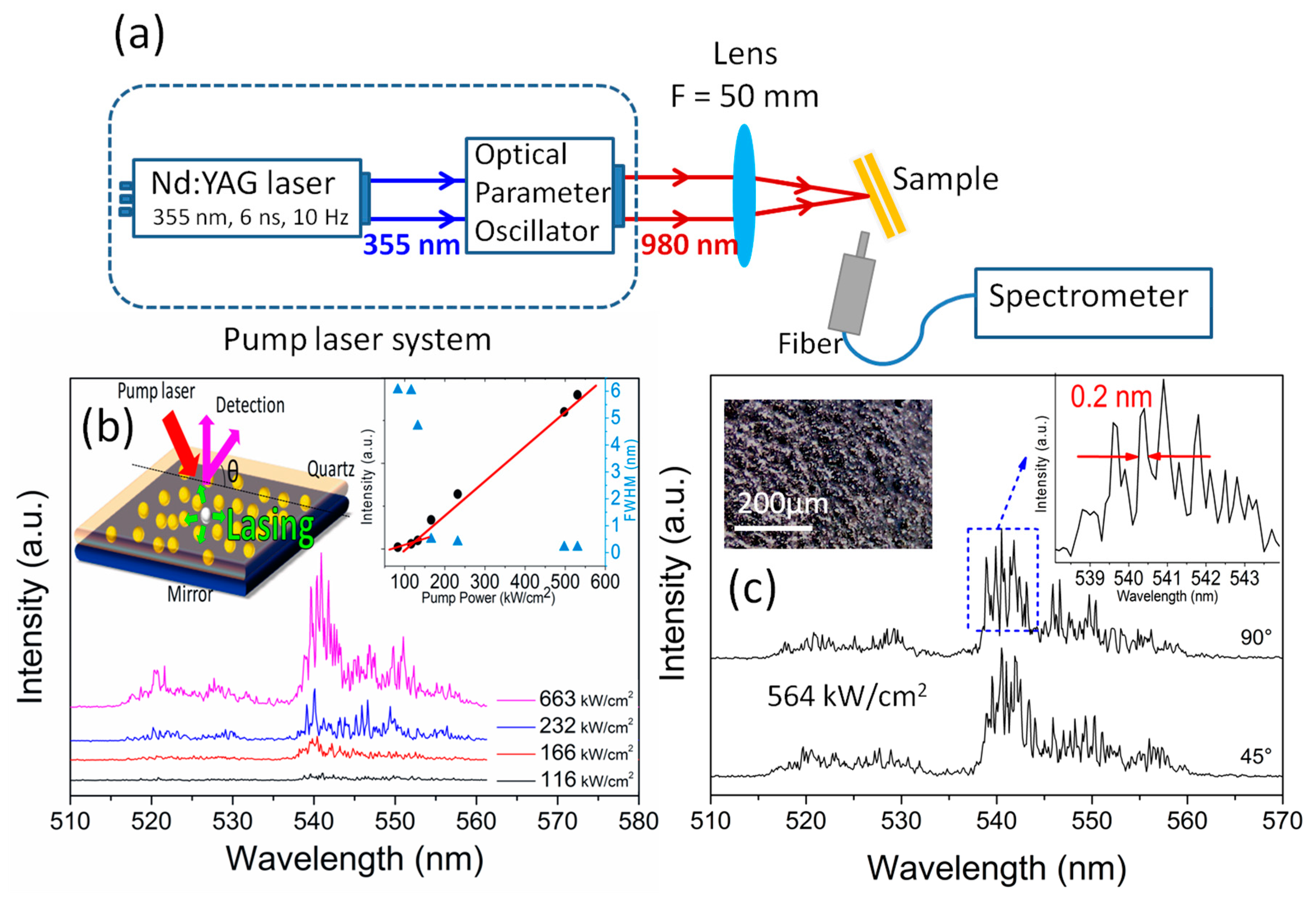
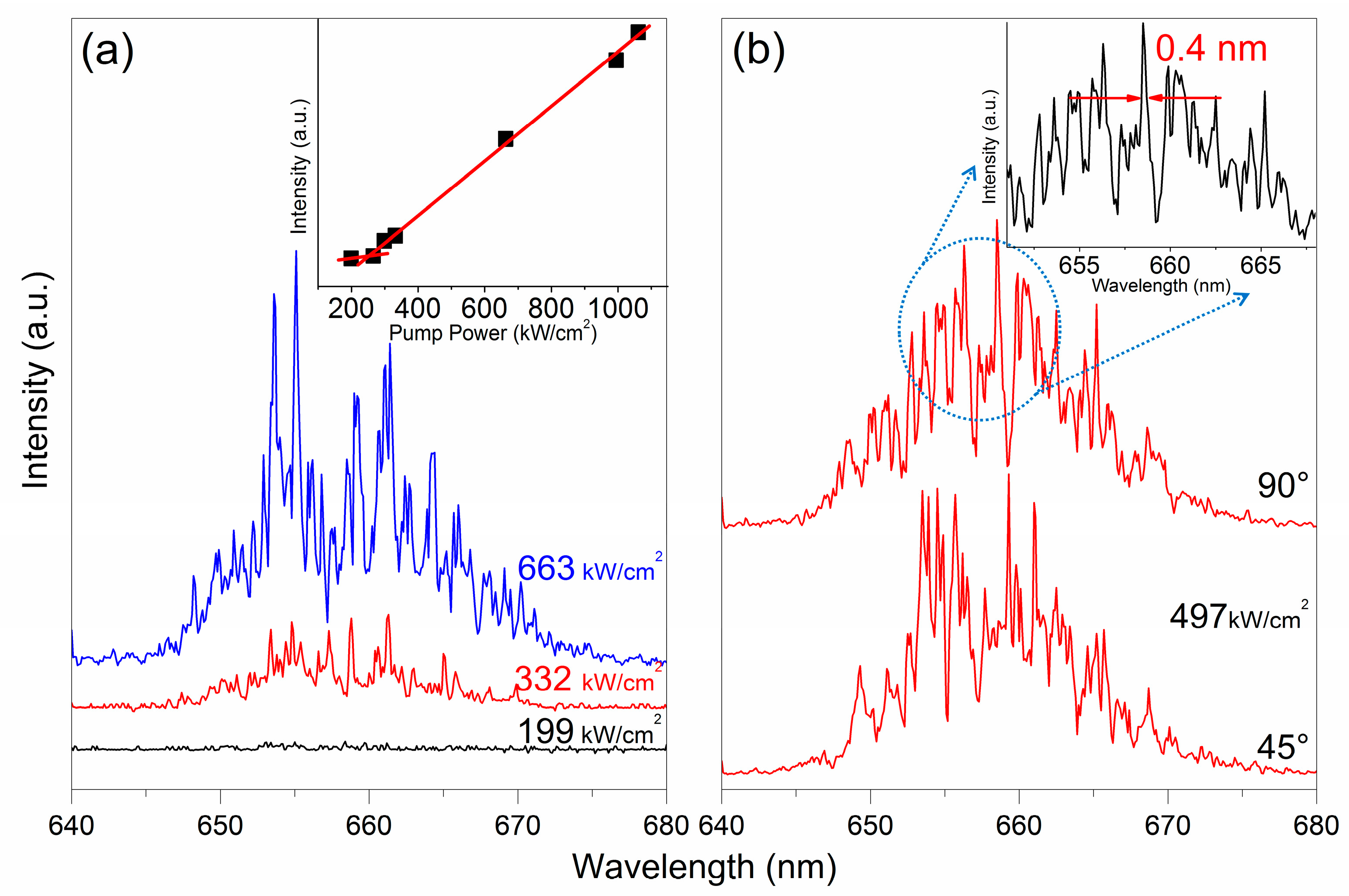
© 2018 by the authors. Licensee MDPI, Basel, Switzerland. This article is an open access article distributed under the terms and conditions of the Creative Commons Attribution (CC BY) license (http://creativecommons.org/licenses/by/4.0/).
Share and Cite
Peng, Y.-P.; Lu, W.; Ren, P.; Ni, Y.; Wang, Y.; Yan, P.; Zeng, Y.-J.; Zhang, W.; Ruan, S. Multi-Band Up-Converted Lasing Behavior in NaYF4:Yb/Er Nanocrystals. Nanomaterials 2018, 8, 497. https://doi.org/10.3390/nano8070497
Peng Y-P, Lu W, Ren P, Ni Y, Wang Y, Yan P, Zeng Y-J, Zhang W, Ruan S. Multi-Band Up-Converted Lasing Behavior in NaYF4:Yb/Er Nanocrystals. Nanomaterials. 2018; 8(7):497. https://doi.org/10.3390/nano8070497
Chicago/Turabian StylePeng, Ya-Pei, Wei Lu, Pengpeng Ren, Yiquan Ni, Yunfeng Wang, Peiguang Yan, Yu-Jia Zeng, Wenfei Zhang, and Shuangchen Ruan. 2018. "Multi-Band Up-Converted Lasing Behavior in NaYF4:Yb/Er Nanocrystals" Nanomaterials 8, no. 7: 497. https://doi.org/10.3390/nano8070497
APA StylePeng, Y.-P., Lu, W., Ren, P., Ni, Y., Wang, Y., Yan, P., Zeng, Y.-J., Zhang, W., & Ruan, S. (2018). Multi-Band Up-Converted Lasing Behavior in NaYF4:Yb/Er Nanocrystals. Nanomaterials, 8(7), 497. https://doi.org/10.3390/nano8070497




